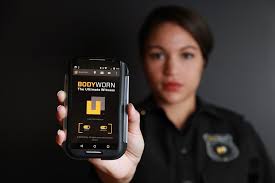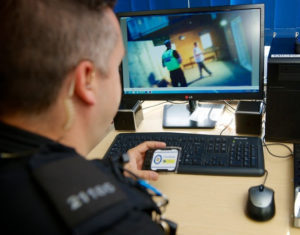An SJC Long Island criminal justice professor who practiced law in Iran before moving to the United States co-authored an article on the effectiveness of body-worn cameras in policing that’s been published in the Journal of Criminal Justice.
Auzeen Shariati, Ph.D., carried out the study and wrote “A Field Experiment of the Impact of Body-worn Cameras (BWCs) on Police Officer Behavior and Perceptions” while earning her doctorate from Florida International University.
 “It’s been a highly debated topic in the past few years,” Dr. Shariati said of body-worn cameras. “We’ve seen an increased attention in this technology across police departments, which was a result of tensions in police community relations, particularly minority communities.”
“It’s been a highly debated topic in the past few years,” Dr. Shariati said of body-worn cameras. “We’ve seen an increased attention in this technology across police departments, which was a result of tensions in police community relations, particularly minority communities.”
Police departments across the country are increasingly using body-worn cameras with hopes of alleviating rising tensions between civilians and officers by increasing police accountability and transparency, Dr. Shariati explained.
We definitely need more research to better understand how successful this tool has been in achieving these goals.” – Auzeen Shariati, Ph.D., professor of criminal justice at SJC Long Island
In order to learn just how effective body-warn cameras are on the behavior and perceptions of police officers, Dr. Shariati and two colleagues from Florida International University developed a test pilot program using a partial randomized experimental design. The police department in Hallandale Beach, Florida, reached out for involvement in their study.
The Results
“In the case of police department that we studied, the community pushed for body-worn cameras after some shootings that happened in the city,” Dr. Shariati said. “They asked for them to increase transparency and reduce tensions between police and citizens. Our study indicated that officers wearing body-cams relied on less intrusive measures, meaning that they made less arrests but gave more citations and had more proactive contacts with citizens (when compared with control officers).”
However, their findings also indicated that officers’ perceptions of body-worn cameras remained pessimistic.
“Although a mandatory activation policy was set forth by the police department that we studied, our analysis showed that activation rate went lower over time, which might be a result of officers’ pessimistic perceptions of body-worn cameras,” Dr. Shariati said.
One reason some police officers are unwilling to turn on the body-worn cameras is the so-called “de-policing effect.”
 “We realized officers were concerned about (the de-policing effect) when we first started this research,” Dr. Shariati said. “This means that officers wearing body-cams might be reluctant to perform their normal duties when they know they are being watched. For instance, use of force is acceptable and even needed when a suspect is posing a serious threat to people’s lives.
“We realized officers were concerned about (the de-policing effect) when we first started this research,” Dr. Shariati said. “This means that officers wearing body-cams might be reluctant to perform their normal duties when they know they are being watched. For instance, use of force is acceptable and even needed when a suspect is posing a serious threat to people’s lives.
“In this case, if body-cams make officers hesitant in performing their policing tasks because they are afraid of the evidence collected by cameras, this tool will be of a negative effect,” she continued. “However, our analysis provided evidence against this claim, showing that it’s not inhibiting officers’ normal duties.”
The Next Step
While policing agencies have invested millions of dollars into body-worn camera programs, many factors remain unclear in the determining the usefulness of body-worm cameras.
“One thing to consider is the costs for storage and management of the videos,” Dr. Shariati said. “We have to see if the benefits outweigh the costs and whether the intended outcomes are achieved. We definitely need more research to better understand how successful this tool has been in achieving these goals.”
